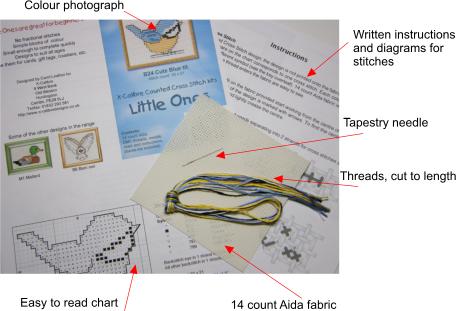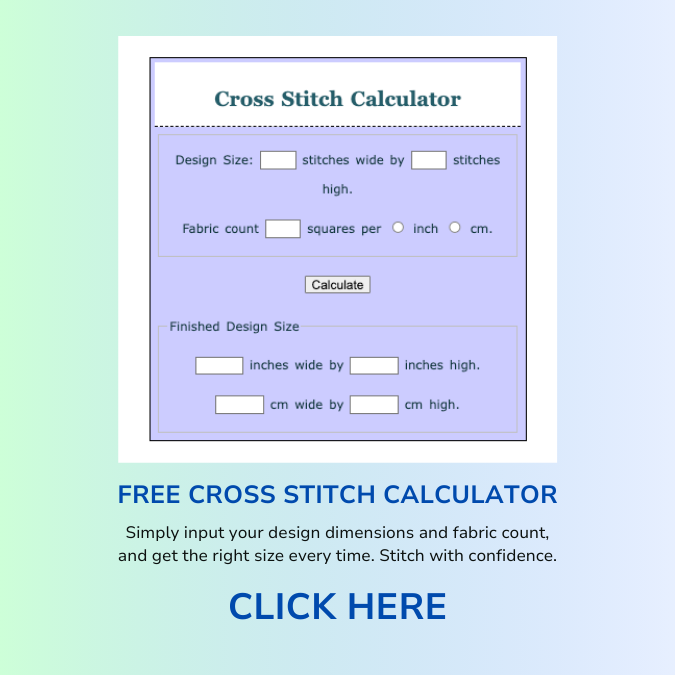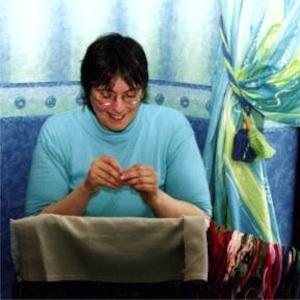- Home
- Cross Stitch
Cross stitch: paint pictures one "X" at a time
Can't draw? With a chart and a palette of coloured threads, each stitch becomes a brushstroke, bringing your subject to life stitch by stitch.
A Gentle Warning!
That little whisper of 'just one more stitch' is a quiet spell.
You get lost in the steady, rythm. Suddenly, an hour has vanished. One petal blooms, then another. Before you know it, a whole flower is smiling up at you.
I used to get completely overwhelmed by the idea of a “finished piece.” It felt like so much pressure that I’d just put my needle down before I even started.
So, I want you to try a little game with me: the Ten-Minute Dare. Find a piece of fabric. Your only goal is to stitch one straight line in the next ten minutes. That’s it. Zero pressure. Just focus on the gentle pull of the thread and the quiet pop of the needle.
This isn’t about making progress. It’s about hitting the reset button on your day—a reminder that we can stitch a little calm into our lives whenever we need it.
When you feel that satisfying little pop of the needle going through the fabric for the first time, that’s it. Fear melts away.
It’s not just a stitch; it’s the beautiful, tangible start of a story we all get to tell, one thread at a time.
Cross Stitch Beginners: Where to Start?
You’re simply making little X-shaped stitches on a grid-like fabric to bring a picture to life. And if you can make an 'X', you can create your first mini masterpiece tonight.
It might seem complicated, but I promise you’re just a few stitches away from your first aha moment.
The real magic is how quickly you’ll have something to show for it. In just one afternoon, you can turn a few stitches into a tiny framed keepsake, a perfect, personalized gift.
Wondering what makes cross stitch different from freehand embroidery? The secret is surprisingly simple: it’s all about the grid! See how this makes cross stitch so beginner-friendly in my guide Cross Stitch vs. Embroidery
Your First Steps into a World of Stitching Delight
Here’s your quick-start guide to that first magical stitch.
- Step 1: Grab Your Three Essentials. You just need a piece of 14-count Aida fabric, some colorful DMC cotton thread, and a blunt size 24 tapestry needle. That’s it!
- Step 2: Your First Project—A Tiny Target. Don't get overwhelmed by a huge design. Your goal is to complete one tiny motif, no bigger than 10x10 stitches.
- Step 3: Make Your First Stitch. Follow your pattern to make a small cross with your thread. Your only job is to finish that tiny shape. Seeing that little heart appear is pure magic. Congratulations, you're a stitcher! Now, what to do with your masterpiece? Turn it into a fridge magnet or glue it onto a blank card. You made something, and that’s a victory worth celebrating.
My first attempt
I found the craft one lazy summer afternoon.
I’d bought the basics and a simple angel pattern, certain I’d make a mess of it.
The shop owner, Rita, must have seen the doubt on my face. She took the hoop from my hands and said, “Don't pull the thread so tight, dear. You have to let it breathe.”
That night, with her words in my ear, I made one stitch. Then another. I was back the moment her shop opened the next morning.
It was the start of everything. The quiet pop of a needle, a single piece of advice—a beginning that simple is waiting for you, too.
Choosing the Perfect Beginner Pattern
Some cross-stitch patterns bite back with a confetti of confusing colors and fractional stitches. Let's find the friendly ones that get you to a proud finish - faster.
 One of my cross stitch beginners kits
One of my cross stitch beginners kitsSmall is Beautiful: There’s nothing like snipping that final thread. Holding a finished piece in your hands - often after just one session. That quiet rush of “I made this” is what keeps your hands coming back to the hoop.
For your first project, pick a chart with bold colour blocks — think cartoons, not portraits. A great starting point is a pattern with 3–5 main colors plus 1 accent. And here’s a quick hack: If you can't tell ★ from + at a glance, skip it. You want the thrill of finishing, not a hoop-sized headache.
Aida Cloth: Aida is a beginner-friendly fabric with a grid-like weave. The evenly spaced holes make it easy to see where to insert your needle, and the squares on the fabric correspond perfectly to the squares on your pattern (also called a cross stitch chart). Most beginner kits use 11 or 14 count Aida. The "count" refers to the number of stitches per inch. As you gain confidence, you can explore different Aida counts or even other fabrics like evenweave or linen.
Hold the fractional stitches: I remember staring at my first pattern, feeling my confidence dip when I hit a symbol for a ‘fractional stitch.’
These are tiny quarter or half stitches used for smooth curves, and while they’re a great skill to have, I’d gently suggest saving them for your next project.
For now, if you encounter one, just work a regular cross stitch in that square using whichever thread color is most dominant. It might make a curve a little more ‘blocky,’ but this simple swap goes a long way toward easing the beginner headache.
It’s about choosing joy over frustration. We want our first project to be a win, and simplifying like this ensures you can focus on the pure magic of watching your picture come to life.
Free Patterns for Eager Stitchers
Ready to get stitching? I've designed a collection of free cross stitch patterns, including some delightful seasonal designs, just for you!
From Stitches to Showcase: Presenting Your Creations
One of the best things about cross stitch is its versatility.
Stitch stunning pictures, personalize gifts with initials or names, create charming bookmarks, or even craft unique home décor items. Small projects are perfect for handmade greeting cards.
Framing on a Budget: Professional framing can get pricey. Don't worry! I'll show you how to frame your cross stitch masterpieces yourself and save a bundle. My step-by-step tutorial makes it a breeze!
Ready for More Stitching Adventures?
Have you trained your family to understand that "5 minutes" actually translates to 2 hours of blissful stitching? If so, you're ready to level up your cross stitch game!
Are you ready to...
- Change the size of your project?
- Explore the world of evenweave and linen fabrics?
- Are you having trouble seeing your stitches?
- Even sell your unique creations?
Have you mastered...
- Stitching on your clothing using waste canvas?
- How to embellish your work with beads?
- Stitching with luxurious rayon thread?
- Using a laying tool for perfectly smooth stitches?
- Designing your own patterns on paper?
- Using computer software to create designs?
Let's troubleshoot!
- Have you got a stain on your finished piece?
- Would you like to wash your finished cross stitch?
- Would you like to ask a question?
Ready to expand your horizons?
What Other Visitors Have Said
Click below to see contributions from other visitors to this page...
How do I follow a cross stitch chart 




I’m starting cross stitch for the first time, as an 86 year old male! My design is not printed on the Aida.
If you complete a line and when you transfer …
Backing a cross stitched baby quilt 




Hi Carol, I have just discovered your website and find it very useful! Much easier to understand than kit instructions. Currently, I am stitching a stamped …
how to fix a cross stitch when I have miscounted 




I am doing this counted cross stitch. it is of muted green colours which represent soft foilage. I have counted and counted, I think I have old eyes. …
single cross stitch 




How do I start and finish a single cross stitch, without running the floss over an empty area to start another x?
That is a great question, Kim. …
How do you finish a cross-stitch afghan 




I'm half-way through making an afghan for my new grand-daughter (using Q snaps for a hoop) and I'm wondering how to finish it when it's done. Should you …
The back of a cross stitch piece 




I love working on the picture, and this is my 5th picture using 50+ colors. My question is what does everyone else's backside look like?
I read that …
cross stitch baby quilt 




I am cross stitching a stamped baby quilt. How do I finish my threads and not show at the back of the quilt?
embellished cross stitch 




I've been seeing some cross stitch kits online that say they are embellished. What exactly does that mean?
Complex cross stitch patterns 




I have cross stitched for over 20 years. Most of the things i have done have big areas of one color.
I am now doing a very complex pattern where there …
How many hours stitching per day? Not rated yet
How many hours a day is it alright to embroider? To cross stitch in particular?
I get quite carried away sometimes and I know it's not good for back …
Stay connected between projects
If you’d like occasional updates from my embroidery room, including new patterns, gentle tips, and little things I think you might enjoy, you’re warmly invited to join the Stitchin’ Times newsletter.
No pressure. Just a friendly note now and then to keep you inspired.






















